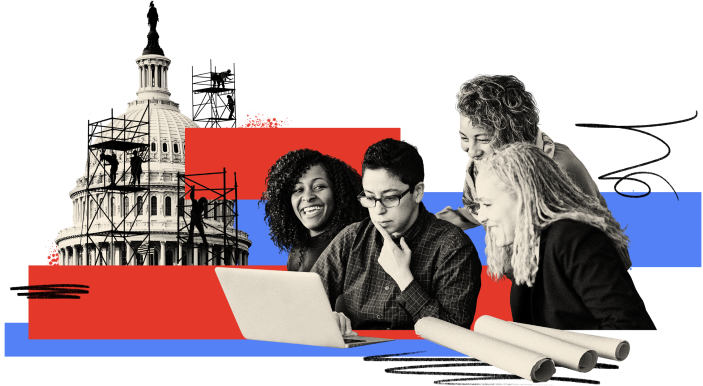William Howell is the Sydney Stein Professor in American Politics at the University of Chicago Harris School of Public Policy, a professor in the Department of Political Science and the College, and the director of the Center for Effective Government.
Beyond Lawyers and Technocrats
- December 13, 2021
This essay is part of Protect Democracy’s Democracy Endgame series, in which leading thinkers were invited to offer their own views on possible paths out of the United States’ democratic crisis. This essay reflects solely the viewpoint of its author and not of his affiliated institutions or of Protect Democracy.
Signs of democratic breakdown are everywhere: the partisan manipulation of electoral procedures, disbelief in election outcomes, distrust in political institutions, the legislative gridlock that just never seems to break. While exact remedies are elusive, the means of achieving them are not. Democracy will not be saved through strictly legal or technocratic interventions. Rather, its redemption requires a diverse coalition that enjoins the participation of attorneys and politicians, yes, but also activists, organizers, business people, journalists, clergy, and academics in both the social sciences and humanities.
The many gatekeepers that line the legislative process and the deep divisions of authority that mark our system of separated powers make broad coalitions a virtual prerequisite for systemic policy change. And when this change is in the service of democracy itself, diversity is indispensable. To combat the cynicism, demagoguery, and us-versus-them worldview that sit at the center of the autocrat’s project, we will have to enlist far more than lawyers and technocrats.
President Biden seems to understand this. In a speech at the National Constitution Center in July, Biden denounced the efforts by some state legislatures to politicize the administration of elections as the “twenty-first century Jim Crow.” To counteract these efforts, Biden advocated not only for congressional action, but also for a broad-based movement in the service of democratic renewal. “We have to forge a coalition of Americans of every background and political party—the advocates, the students, the faith leaders, the business executives—and raise the urgency of this moment.”
Indeed we do. But Biden’s rhetoric has not always translated into practice. For example, while Biden should be applauded for assembling a bipartisan commission to analyze potential reforms to the Supreme Court, the commission consists of an extraordinarily narrow constituency of would-be reformers: all 36 commissioners have law degrees and serve either as federal judges or law professors. By offering commission seats exclusively to members of the legal profession, Biden all but ensured that that foundational questions about the appropriate role of the courts in a democracy would not be explored; that deliberations instead would circle around narrower, procedural concerns; and that the country, when all was said and done, would still lack anything approximating a roadmap or mandate for systemic change.
As the Biden administration carries out the Summit for Democracy and the year of action it inaugurates, we can hope that a more diverse assembly of democracy reformers is included. Encouragingly, the administration promises to “build a broader community of partners committed to global democratic renewal.” It must deliver on this front. The ambition and quality of a reform agenda, after all, can be measured against the size and diversity of the coalition it enlists. Reform movements succeed when they feature a broad array of talents, experiences, outlooks, and expertise, all united behind common goals.
Consider the lessons of past democracy movements. In the United States, the Progressive Era was a time of economic and social upheaval that resulted in new checks on corporate power, a slew of labor laws, and a modern civil service. The Progressive Era also was a time of democratic revival. Reformers established the nation’s first direct primaries, ballot initiatives, and recall elections that were intended to guard against political corruption and patronage. Through the Nineteenth Amendment, women were finally given a voice in the democratic process. Reformers also sought to expand and empower the presidency, the only government office for which all Americans can cast a ballot.
These were the hard-fought victories of a coalition of social scientists, philosophers, Social-Gospel Christians, novelists, muckraking journalists, teachers, social workers, and more. While this coalition surely included highly compensated attorneys and business leaders—the so-called “mugwumps” bitterly opposed to political corruption—they alone did not define a movement whose activities took place in settlement houses, churches, and schools. Rather, the movement’s most recognizable characters included scholar-activists (such as W.E.B. Du Bois) and the college-educated women (such as Jane Addams) who helped disperse their reformist ideas. Michael McGerr put the central lesson of the Progressive Movement this way: “Successful regulation required not only a powerful sense of urgency but a broad, cross-class coalition.”
And so it was during the civil rights movement that followed, when racial minorities joined coalitions of faith leaders, students, and activists to demand the fuller benefits of citizenship. Their efforts—and especially the combined work of the National Association for the Advancement of Colored People, Urban League, Congress of Racial Equality, and Student Nonviolent Coordinating Committee—made politically possible the Civil Rights Acts of 1957 and 1964 and the Voting Rights Act of 1965. Writes Sheryll Cashin, “This transformation in majoritarian democratic opinion would not have happened through mere reliance on the leadership of political elites.” Yet again, meaningful and enduring democratic reform depended upon the participation of a diverse array of interest and identity groups.
Of course, movements for political equality continued long after the 1960s. Earlier this year, coalitions of activists, entrepreneurs, and academics came together to challenge voting restrictions in several states. In Georgia, Stacey Abrams’s Fair Fight was far from the only organization to rise up against SB 202, the omnibus elections bill signed by Governor Brian Kemp in March. A joint legal challenge was immediately filed by the Georgia NAACP, Georgia Coalition for the People’s Agenda, League of Women Voters of Georgia, GALEO Latino Community Development Fund, Common Cause, and the Lower Muskogee Creek Tribe. In June, faith leaders representing more than 1,000 churches staged a protest at the Georgia Capitol, led by Bishop Reginald Jackson of the African Methodist Episcopal Church.
Corporate leaders and academics soon joined the fight. As the Major League of Baseball pulled its 2021 All-Star game out of Georgia to protest SB 202, nearly 300 CEOs including Jeff Bezos and Mark Zuckerberg signed a statement condemning similar laws in Texas and elsewhere. Similarly, more than 100 scholars of democracy signed a statement of concern over the “deterioration of U.S. elections and liberal democracy” at the hands of Republican-led state legislatures. So doing, each group contributed its own perspective, strengthening the movement’s core. For academics, it was an informed perspective of how and why democracies fail. For CEOs, it was the view that “If you lose the democracy, you lose capitalism.” And for the Sierra Club—which recently joined a protest coalition against Texas voting restrictions—it was an understanding that the preservation of democracy is a prerequisite for environmental protection.
Similar examples of diverse coalitions defending democracy can be found abroad. For example, in countries as diverse as Mexico, Turkey, Serbia, and the Czech Republic, aspiring autocrats have sought to eliminate judicial checks and interferences on their rule. Their playbook—elements of which we have seen in the United States—includes changing procedures for nominating and appointing judges, imposing mandatory retirement ages to rid the courts of independent judges, placing the courts under the ministry of justice, and, as a last resort, simply ignoring and refusing to publish unfriendly decisions.
Political opposition leaders and even international bodies, like the European Union, have had mixed success in resisting these strategies. But to the extent that resistance has succeeded, it has come from a diverse assembly of grassroots organizations, civil society groups, and social movements.
Consider government-judicial conflict in Poland. In 2015, the Law and Justice Party’s (PiS) presidential candidate, Andrzej Duda, gained the presidency, and his victory was followed later that year by a PiS majority victory in the Sejm, the national parliament. Among its first official acts, the new PiS government engaged in a full-on, multi-year attack on judicial independence. The attempted “reforms” included requiring that constitutional court decisions secure concurrence of two-thirds of the justices (though the Polish constitution required only a majority). Any three justices would henceforth be able to demand that a case be heard en banc—that is, by the full court—and the Prosecutor General would have to be present at all such sessions.
Effective pushback against these reforms came not from judicial organizations, retired judges, or lawyers—or not these alone—but from an energetic protest movement. When the Sejm proposed in 2017 to place the constitutional court inside the Justice Ministry—further exposing the court to political influence—a popular outcry promptly ensued. In July of 2017, President Duda surprised Poles by vetoing this aspect of the reforms. Duda claimed that he vetoed the change after consultations with legal experts, but that same weekend, thousands of Poles had taken to the streets in cities across the country, protesting the de facto absorption of the constitutional court into the government.
When a party like PiS, and a leader like Duda, set their sights on democratic institutions, resistance must be sustained by large-scale coalitions. In Hungary, Viktor Órban and his Fidesz party have undermined governmental, academic, and civil-society institutions, in much the same way that Duda and PiS did in Poland. In Hungary, too, broad-based movements have been more successful at putting up effective resistance than have elite actors alone, which has yielded some notable victories in a period of otherwise deeply troubling democratic backsliding. In June of 2021, for instance, the Hungarian government announced a major investment in a Chinese university campus in Budapest, after years of funding cuts and closures of universities serving Hungarian students. The announcement was followed by massive street protests, involving students, faculty, and civic groups. After the weekend of protests, the government backtracked on the Chinese campus.
A final example of effective democratic resistance can be seen in Chile. Beginning in October 2019, a government-mandated subway fare rise sparked sustained protests that eventually involved an estimated 1.2 million people. The protesters were diverse, and included organizations of high school students, truck drivers, and grandmothers, among others. Their leadership was decentralized, and their demands went well beyond the reversal of the public transit fare increases. The protestors argued that Chile’s constitution desperately needed reform, as it had been crafted by the outgoing Pinochet dictatorship, at the end of the 1980s, with an eye toward preserving the privilege of the armed forces and of conservative parties allied with the military. After originally deploying some 20,000 troops to quell the protests, in November 2019 Chile’s president, Sebastián Piñera, agreed to hold a referendum that asked the public whether a new constitution should be drafted.
In October 2020, the referendum vote was held. The proposal passed with a large majority, thus kickstarting the process of creating a new constitutional assembly. This 155-member assembly was elected in 2021 and is notable for its inclusivity: 77 members are women, 17 seats were designated for indigenous members, and it includes a diverse set of individuals—not just career politicians, but scientists, historians, school bus drivers, and stay-at-home parents. In 2022, when this group is expected to have drafted a new constitution, Chilean voters will once again participate in a referendum, this time to decide whether to enact it. Thus, in Chile we see how a diverse group of engaged citizens can not only slow the pace of democratic erosion, but can pressure political actors to establish new structures that strengthen democracy.
Worldwide, the movements that have defended and improved democratic governance have tended to be broad, multi-class, and multi-organizational. They have drawn upon the expertise and commitments of lawyers and professional politicians, but also of journalists, academics, community organizers, activists, artists, and business people. This is true today in contemporary Eastern Europe and Latin America, just as it was true in the United States of the Progressive and Civil Rights eras. If Biden is to do his part to meet the profound challenges of this present hour, he too must raise the voices of a truly diverse coalition of democracy reformers.
Related Content
Current United States Authoritarian Threat Index score: 3.3/5 Severe Threat •
-
Civil Liberties 3.4/5 • Severe Threat
-
Rhetoric 3.9/5 • Severe Threat
It can happen here.
We can stop it.
Defeating authoritarianism is going to take all of us. Everyone and every institution has a role to play. Together, we can protect democracy.
Donate
Sign Up for Updates Sign Up for Updates
Explore Careers Explore Careers
How to Protect Democracy How to Protect Democracy



